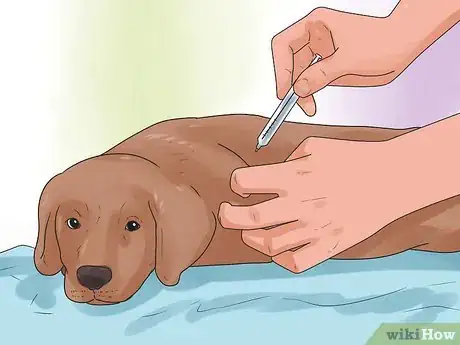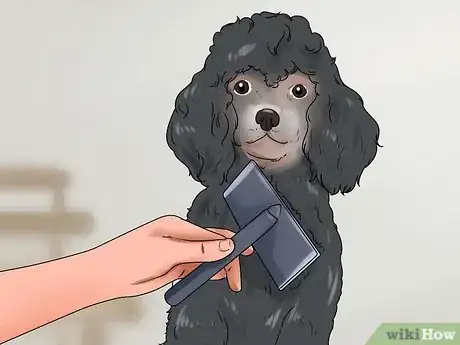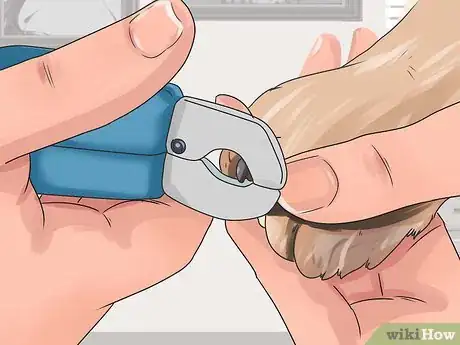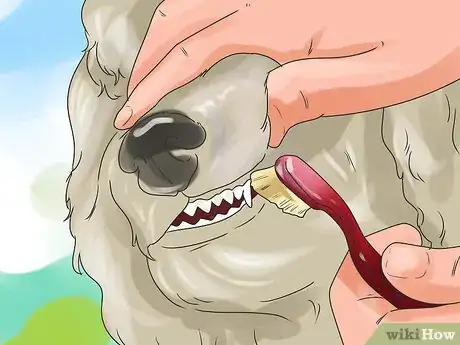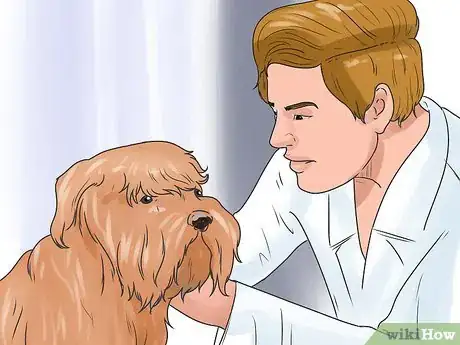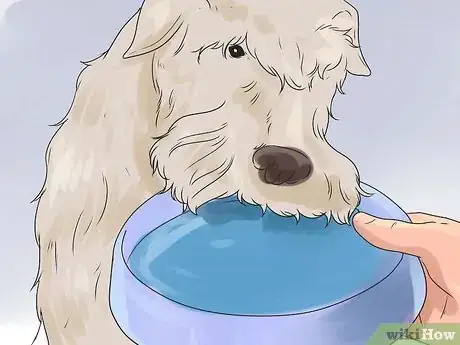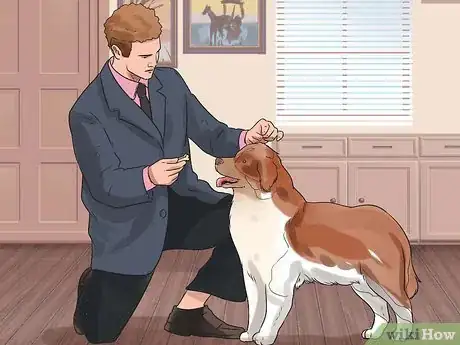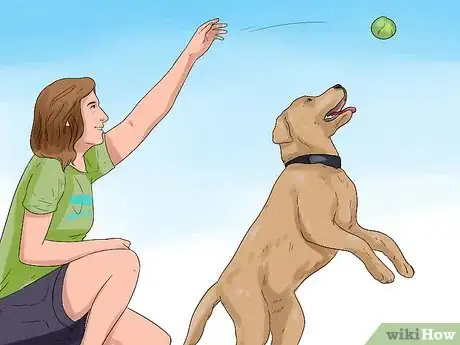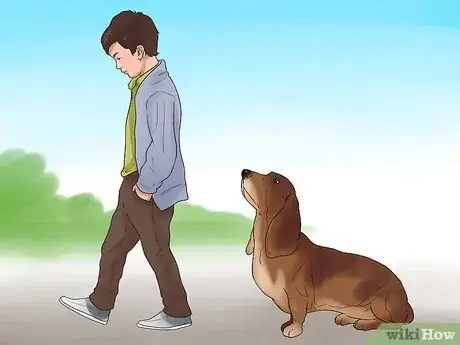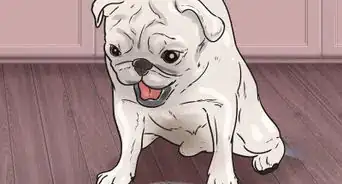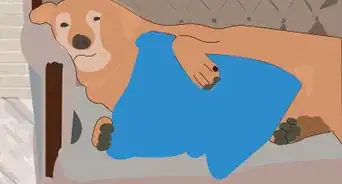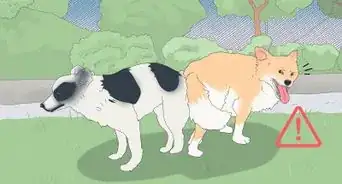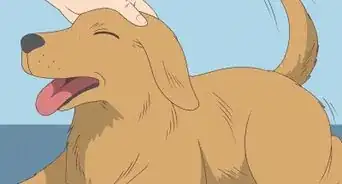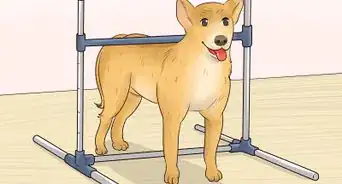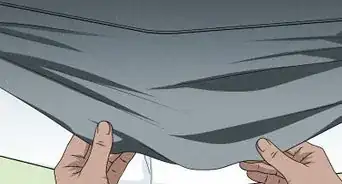This article was co-authored by Brian Bourquin, DVM. Brian Bourquin, better known as “Dr. B” to his clients, is a Veterinarian and the Owner of Boston Veterinary Clinic, a pet health care and veterinary clinic with three locations, South End/Bay Village, the Seaport, and Brookline, Massachusetts. Boston Veterinary Clinic specializes in primary veterinary care, including wellness and preventative care, sick and emergency care, soft-tissue surgery, dentistry. The clinic also provides specialty services in behavior, nutrition, and alternative pain management therapies using acupuncture, and therapeutic laser treatments. Boston Veterinary Clinic is an AAHA (American Animal Hospital Association) accredited hospital and Boston’s first Fear Free Certified Clinic. Brian has over 19 years of veterinary experience and earned his Doctor of Veterinary Medicine from Cornell University.
There are 7 references cited in this article, which can be found at the bottom of the page.
wikiHow marks an article as reader-approved once it receives enough positive feedback. In this case, 80% of readers who voted found the article helpful, earning it our reader-approved status.
This article has been viewed 149,198 times.
Seeing to your dog’s every need is a lot of work, but well worth the effort. If you want to be a good dog owner, there are some simple things that you do for your dog. Some of the things that good dog owners do include taking your dog for regular check-ups, giving your dog baths, providing plenty of fun toys for your dog, and teaching your dog some basic obedience commands. Being a good dog owner takes time and patience, but your dog will thank you with love and affection.
Steps
Protecting Your Dog’s Health
-
1Take your dog to the veterinarian for initial shots and an annual check-up. Regular veterinary care is essential to protect your dog’s health, so good dog owners take their dogs to the vet at least once per year for a checkup and make sure their dogs are up to date on their shots. When you first get your dog, you should take him to the veterinarian for his first check-up and initial shots as well. Then, make sure that you take your dog to the veterinarian once per year for a checkup and updates on shots.[1]
- Observe your dog for signs of a health issue. Being a good dog owner also means taking your dog to the veterinarian right away if you suspect that he is having a health issue. If you notice that your dog seems sick or that his behavior has changed, schedule an appointment with your veterinarian right away to find out what is going on.
-
2Administer flea, tick, and heartworm prevention medications as needed. Flea, tick, and heartworm medications are necessary to protect your dog from preventable health problems. Make sure that you administer these medications as recommended by your veterinarian along with any other medications that your veterinarian prescribes for your dog.[2]Advertisement
-
3Spay or neuter your dog. This helps stem the tide of companion-animal overpopulation. Spaying female dogs reduces the stress and discomfort endured during heat cycles, eliminates the risk of uterine cancer, and greatly reduces the risk of mammary cancer. Neutering makes male dogs much less likely to roam or fight and prevents the small risk of testicular cancer.
- However, simply calming your dog during her heats, having a fence, supervising your dog and training them properly can reduce or eliminate many of these behaviour-related concerns.
- Alternative options are available, too, such as vasectomy, neutering, tubal ligation and ovary-sparing spay (OSS). While harder to come by, they come with less long term health risks than spaying and neutering. Spaying and neutering comes with many associated health risks such as different types of cancers, orthopedic disorders and cardiac hemangiosarcoma.[3]
- You'll need to keep your dog relaxed and prevent it from licking its wound while it heals from its surgery, but your pup should bounce back relatively quickly![4]
-
4License your dog. Getting your dog licensed and purchasing dog tags for him/her is important in case he/she ever runs away or gets lost. It doesn’t cost much to license your dog and in most states you are required to license your dog and keep his/her tags on his/her collar at all times. Not doing so may cost you up to $250. Your dog’s tags should include his name, and your phone number or street address.
- You may also consider microchipping your dog to increase your chances of finding him/her if he/she runs away or gets lost. Your veterinarian can inject a microchip with a tracking number on it that can be scanned in the event that your dog gets lost and ends up in a shelter.[5]
Grooming Your Dog
-
1Wash your dog as needed. If your dog has short hair, give your dog a bath once every three months. If your dog has long hair, you may need to bathe him/her more often. To wash your dog, wet all of your dog’s fur with a spray hose or a pitcher, but do not wet the areas around his/her eyes, ears, and nose. Then, massage some shampoo into your dog’s fur. After you have worked the shampoo into a lather, rinse out all of the shampoo. The water should run clear and without suds. Then, dry him/her off with a towel.[6]
- Don’t use human shampoo on your dog, because some ingredients in human products can be irritating to dogs. Use a special dog shampoo when you wash your dog.
- Offer your dog plenty of praise and a treat after baths to help him/her develop positive feelings about bath time.
-
2Brush your dog. If your dog has short hair, you may only need to brush him/her once a week. If your dog has long hair, you will need to brush him/her every day in order to avoid tangled and matted fur. Use a wide comb to help remove tangles before moving on to a brush. Make sure that you offer your dog lots of praise while you brush him/her and give him/her a treat when you are finished so that he/she will be willing to let you brush him/her on a regular basis.[7]
-
3Clip your dog's nails. To clip your dog’s nails, you will need to get a special nail clipper for dogs. You can purchase dog nail clippers in a pet store. You may also need to get your dog used to you handling his nails before you try to clip them. If your dog is wary of you touching his/her feet and nails, help him/her get used to it by petting his/her feet and touching his/her toes. Give him/her praise and a treat when he/she lets you touch his/her toes. After he/she becomes more comfortable with you touching his/her feet, you can try to clip his/her nails.[8]
- Make sure that you do not cut too far down or you may hit the quick of his/her nail. This area is very sensitive and may cause bleeding.
- If you are concerned about hurting your dog while trimming his/her nails, ask your vet to show you how or have a professional groomer trim your dog’s nails for you.
-
4Brush your dog’s teeth. Brushing your dog’s teeth can help to prevent problems with tooth decay and gum disease as your dog ages. If your dog has bad breath, it may indicate that there is excess bacteria causing a problem. Take your dog to have his/her teeth cleaned by a veterinarian and then follow your veterinarian’s instructions for cleaning his/her teeth.
- You can use a child’s toothbrush, a gauze pad, or even a bit of nylon stretched over your finger to clean your dog’s teeth. Make sure that you use a special dog toothpaste or mix some baking soda with a bit of water to form a paste.[9]
-
5Inspect your dog for problems during grooming times. Grooming time is a good time to check your dog for fleas, ticks, and other potential health problems. Make sure that you inspect your dog’s skin for any unusual growths, wounds, or tender areas. You should also check your dog’s ears for excessive wax buildup and foul odors. If you find anything that seems abnormal, schedule an appointment with your veterinarian as soon as possible.[10]
Feeding Your Dog
-
1Understand your dog’s dietary requirements. The amount and frequency of your dog’s feedings will depend on the age and size of your dog. Talk to your veterinarian if you are unsure about how much you should be feeding your dog. In general, adult dogs only need to be fed once per day and the amount they need is based on their weight. You can usually find weight charts on dog food packages that indicate how much food your dog needs each day.[11]
- Keep in mind that dogs under the age of one will need to be fed more frequently. Puppies from 8-12 weeks old need to be fed four times per day. They also require special puppy food. Check with your veterinarian to be sure that you are giving your dog the right type and amount of food every day.[12]
- Larger dog breeds need special large-breed dog food while they're growing so they get all of the nutrients they need.[13]
- In general, look for dog food that contains ingredients you can easily pronounce since it will be less likely to have unhealthy additives and other ingredients.[14]
-
2Make sure your dog always has access to fresh clean water. Dogs need plenty of fresh clean water to drink every day. Your dog may need more water if he has been exercising or if the weather is hot. Make sure to provide a bowl of water that your dog can access easily. Refill it if the water gets low, and change the water daily.[15]
-
3Give treats for good behavior. It’s nice to indulge your dog with a treat now and then to show that you care about him/her. Treats can be used to reward good behavior as well. Reward your dog with a treat every day, such as a homemade dog biscuit or a store-bought rawhide bone.
Exercising Your Dog
-
1Walk your dog every day. Dogs require daily exercise to be healthy and happy. Walking your dog every day is great way to help your dog get the exercise he/she needs. Your dog’s exercise needs will vary based on his/her breed, which means that some dogs will be content with a quick walk around the neighborhood, while others will require at least an hour of walking every day.[16]
- Consider your dog’s energy level to determine how much and how often you should be walking him/her.
-
2Play with your dog. Since not all dogs can do what they were bred to do, such as hunt or dig, it is important to play with them every day to keep them from forming destructive behaviors. Take your dog outside every day for a game of fetch or play tug of war with a special rope toy. Just make sure that you are doing something to stimulate your dog’s body and mind every day to prevent boredom.[17]
-
3Give your dog plenty of opportunities to go outside. In addition to daily walks and playtime, your dog may benefit from freedom to go outside a few times every day. An enclosed backyard or a long line are ideal so that your dog can run and explore his/her domain. If you let your dog out and do not join him/her outside, make sure to check on him/her from time to time.
- If your dog often spends time outside during the warmer months, make sure that he/she has a shady place to get out of the sun and plenty of fresh, clean water and food.[18]
Training Your Dog
-
1Consider enrolling your dog in an obedience course. Good dog owners put in the time and effort that is needed to train their dog basic commands. An obedience course can help you teach your dog some basic obedience skills such as sit, stay, and lay down. Going through an obedience course with your dog can also help you to build a better bond with your dog, which will benefit both of you.[19]
- You may also consider working one-on-one with a certified professional dog trainer. This is a good option if your dog is not a big fan of other dogs and people, or if you just want more attention and help from the trainer.
-
2Keep training sessions short and regular. For the best results, train your dog in short sessions and repeat the sessions regularly. One way that you can train is by doing 5-15 repetitions of a behavior, such as teaching your dog to sit. Then, switch to a different behavior, and then another. Do these repetitions during one 15 minute session every day. Keeping training sessions short will help your dog pay attention. The frequency of your training sessions will help reinforce what you want your dog to learn.[20]
-
3Use positive reinforcement. To teach your dog to do what you want him/her to do, it is important to reward his/her good behavior as soon as he does it. For example, if you ask you dog to sit and he/she does, praise and pet him/her right away so that your dog knows that he/she did something good. Try to reward your dog whenever he/she does good things so that he/she knows that these are the behaviors you like.[21]
-
4Ignore bad behavior. Teach your dog to stop doing bad behaviors by ignoring him/her when he/she is naughty. For example, if your dog wants to go for a walk and he/she is jumping on you to let you know, ignore him/her and wait until he/she stops jumping. When he/she stops and stands still, put on his/her leash and take him/her for a walk. Repeat this process every time you walk your dog to help him/her understand that you do not want him/her to jump. He/she will learn that jumping up and down does not lead to a walk, but standing still does.[22]
- Never hit or scream at your dog if he/she does something bad. Punishing your dog in this way does not solve the problem and it may even make the problem worse.[23]
- Consult an animal behaviorist or certified professional dog trainer if you are having problems with training your dog.
Loving Your Dog
-
1Provide your dog with plenty of toys. Good dog owners make sure that their dogs have toys to play with. Make sure that your dog has plenty of toys to keep him stimulated and happy. Some good options are chew toys, squeaky toys, rope toys, frisbees, and tennis balls. Find out what your dog likes best and make sure he/she has some favorite toys to play with at all times.
-
2Give your dog a soft spot to sleep every night. Good dog owners don’t make their dogs sleep on the bare floor or outside in the cold. Make sure that you invest in a nice soft doggy bed for your dog when you first get him/her and line it with a blanket. Wash the blanket regularly to keep it clean and dry. Keep your dog’s bed in a warm part of the house that is free from drafts.[24]
-
3Shower your dog with love and affection. Dogs provide their humans with love, affection, and companionship, so why not return the favor? If you really want to be a good dog owner, make sure that you shower your dog with lots of love and affection. Pet him/her, praise him/her, and do nice things for him/her so that he/she knows that you care.
Expert Q&A
-
QuestionDo I need to groom a short-coated dog such as an American Staffordshire terrier?
 Pippa Elliott, MRCVSDr. Elliott, BVMS, MRCVS is a veterinarian with over 30 years of experience in veterinary surgery and companion animal practice. She graduated from the University of Glasgow in 1987 with a degree in veterinary medicine and surgery. She has worked at the same animal clinic in her hometown for over 20 years.
Pippa Elliott, MRCVSDr. Elliott, BVMS, MRCVS is a veterinarian with over 30 years of experience in veterinary surgery and companion animal practice. She graduated from the University of Glasgow in 1987 with a degree in veterinary medicine and surgery. She has worked at the same animal clinic in her hometown for over 20 years.
Veterinarian Ideally yes. Use a rubber slicker as this will remove shed hair and at the same time massage his skin. Do this once a week and it helps spread the natural oils over his coat which gives a lovely seal-like gloss on the coat.
Ideally yes. Use a rubber slicker as this will remove shed hair and at the same time massage his skin. Do this once a week and it helps spread the natural oils over his coat which gives a lovely seal-like gloss on the coat.
Warnings
- Remember that having a dog is a serious, long-term commitment. If you are not prepared to care for an animal for all of its natural life (about 10-20 years) then do not get a dog.⧼thumbs_response⧽
- Never leave your dog outside for extended periods of time. Dogs need and want to be around people.[25]⧼thumbs_response⧽
References
- ↑ http://www.aspca.org/pet-care/dog-care/general-dog-care
- ↑ http://www.aspca.org/pet-care/dog-care/general-dog-care
- ↑ http://www.naiaonline.org/pdfs/LongTermHealthEffectsOfSpayNeuterInDogs.pdf
- ↑ Brian Bourquin, DVM. Veterinarian. Expert Interview. 20 December 2019.
- ↑ http://pets.webmd.com/microchipping-your-dog-or-cat
- ↑ https://www.aspca.org/pet-care/dog-care/groom-your-dog
- ↑ https://www.aspca.org/pet-care/dog-care/groom-your-dog
- ↑ https://www.aspca.org/pet-care/dog-care/groom-your-dog
- ↑ http://www.aspca.org/pet-care/dog-care/general-dog-care
- ↑ https://www.aspca.org/pet-care/dog-care/groom-your-dog
- ↑ http://www.humanesociety.org/animals/dogs/tips/dog_care_essentials.html
- ↑ http://www.aspca.org/pet-care/dog-care/general-dog-care
- ↑ Brian Bourquin, DVM. Veterinarian. Expert Interview. 20 December 2019.
- ↑ Brian Bourquin, DVM. Veterinarian. Expert Interview. 20 December 2019.
- ↑ http://www.aspca.org/pet-care/dog-care/general-dog-care
- ↑ http://www.aspca.org/pet-care/dog-care/general-dog-care
- ↑ http://www.aspca.org/pet-care/dog-care/general-dog-care
- ↑ http://www.aspca.org/pet-care/dog-care/general-dog-care
- ↑ http://www.humanesociety.org/animals/dogs/tips/dog_care_essentials.html
- ↑ https://www.aspca.org/pet-care/virtual-pet-behaviorist/dog-behavior/training-your-dog
- ↑ Brian Bourquin, DVM. Veterinarian. Expert Interview. 20 December 2019.
- ↑ https://www.aspca.org/pet-care/virtual-pet-behaviorist/dog-behavior/training-your-dog
- ↑ Brian Bourquin, DVM. Veterinarian. Expert Interview. 20 December 2019.
- ↑ http://www.aspca.org/pet-care/dog-care/general-dog-care
- ↑ http://www.humanesociety.org/animals/dogs/tips/dog_care_essentials.html
About This Article
To be a good dog owner, take your dog to the vet for annual checkups and shots. You should also ensure your dog gets enough exercise by going for walks every day. To keep your pet healthy and happy, make sure your dog eats quality pet food, always has access to clean water, and has a cozy place to sleep each night. When training your dog, use positive reinforcement by giving treats and praise when your dog does what you want. Avoid hitting or yelling at your dog because these methods are ineffective. For tips from our Veterinary reviewer on how to protect your dog's health, keep reading!

